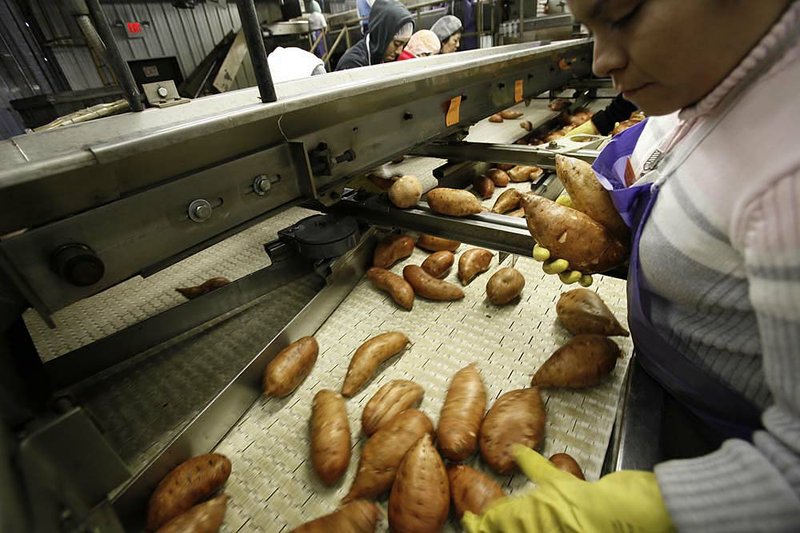RALEIGH, N.C. — The humble sweet potato - a Southern staple and customary Thanksgiving dinner menu item - is suddenly looking a lot more cosmopolitan.
With U.S. consumption growing slowly, farmers have found a market for the vitamin-packed, cholesterol-free sweet potato on the tables of health-conscious Europeans. Between 2005 and 2009, the value of U.S. sweet potato exports more than doubled to $51.4 million, with much of that growth coming from Europe, especially Great Britain.
The value of exports to the United Kingdom jumped from $5.7 million to $20.4 million between 2005 and 2009, and in the first six months of 2010 exports were on pace to comfortably exceed last year’s total, according to the U.S. Department of Agriculture. Even Ireland, famous for its white potatoes, is getting a taste of the orange kind: Ireland only imported $125,000 worth of sweet potatoes last year, but that’s up from none in 2005.
It’s a huge change from even 10 years ago, when European supermarkets branded the sweet potato an “exotic vegetable” and relegated it to a few feet of out-of-the-way shelves in produce sections. The growth has been so swift that it’s hard to isolate a single reason for it.
Matthews Ridgeview Farms, the largest sweet potato producer in Arkansas, works with a broker to ship sweet potatoes to a grocery chain in the United Kingdom. Terris and Kim Matthews,who own the farm, said they also have been pursued by potential customers in Russia and the Netherlands.
“We’re getting a lot of calls, I’ll put it that way,” Terris Matthews said.
This is the third year the farm has worked with the Tesco supermarket chain in the United Kingdom, though heavy rains that damaged the 2009 crop meant there weren’t enough to send overseas that year. The farm plans to start international shipments again after it meets domestic demand for the Christmas season.
But working with international customers can be challenging, with different terms and measurements to keep track of. Even something as simple as finding shipping boxes sized and labeled with metric units can be an expensive headache, Kim Matthews said.
“We’ve got a lot of business here in the U.S., so we’ve got to kind of weigh our options, and it’s something to ease into a little bit at a time,” she said. “But it’s a huge opportunity, it really is.”
Arkansas produced 463,000 hundredweight of sweet potatoes in 2009, valued at over $6 million. This year there were 3,300 acres of sweet potatoes planted - 300 more than last year. Production numbers will be released in January.
Jerome Vick, co-owner of Vick Family Farms in Wilson, N.C., has been growing sweet potatoes since 1982, and in the past five years he’s seen Europe become an increasingly important market. Along with the 40-pound boxes of potatoes he packages for the American market, he sells potatoes in European-standard 13-pound packs.
Vick also follows the food safety standards adopted by European supermarket chains.
“They’re a little more stringent in terms of food safety, and since we’ve always been food safety-oriented on this farm, it was a good fit,” he said.
American farmers are also investing in new equipment to help ensure uniform size and shape in the potatoes, which is important in Europe, said David Picha, a professor at the Louisiana State University Agricultural Center.
Americans have an advantage over rival farmers in countries like Israel, Egypt and South Africa, Picha said.
“We can provide a consistently high quality of sweet potatoes on a year-round basis, and that’s something very few countries can do,” he said. “The main buyers in Europe are the supermarkets, and that year-round consistency is what they’re looking for.”
But the biggest boost might have come from farmers’ recent promotions, which helped inform European consumers about the sweet potato, Picha said.
“Ten years ago, this was an undiscovered vegetable in Europe,” he said. “We’ve done a very good job of promoting it and building awareness of the flavor and nutritional value since then.”
The North Carolina Sweet Potato Commission, for example, has been holding promotions with European supermarkets in the past few years, with the most recent one in Sweden last May.
North Carolina, which grows about 47 percent of U.S. sweet potatoes, is one of the major American producers along with Louisiana, Mississippi and California.
“They’re still grown here and still popular here, but now we’re seeing them become popular with people all over,” said Sue Johnson-Langdon, the executive director of the North Carolina commission.
In the U.S., “value-added” products like sweet potato fries are helping put sweet potatoes on more plates, but not at a rate comparable to countries like Britain. Per capita American consumption slumped between the mid-1980s and 2003, when it began inching upward. It’s now just over five pounds a year.
All the marketing, new standards and new equipment help, but for farmers like Vick, the vegetable speaks for itself.
“Sweet potatoes have always been a popular vegetable in the South, but people in the North have always eaten them a lot, too,” he said. “I guess it just took a little while for the news to make it across the ocean.” Information for this article was contributed by Tom Breen and Emery P. Dalesio of The Associated Press and by Alison Sider of the Arkansas Democrat-Gazette.
Business, Pages 23 on 11/23/2010
